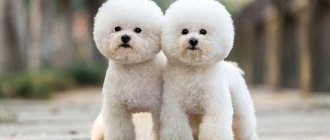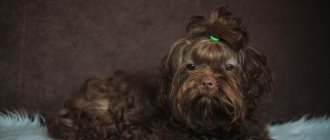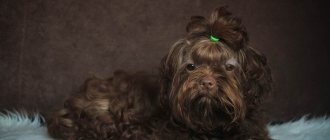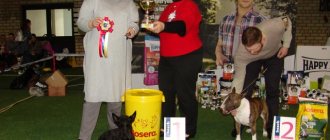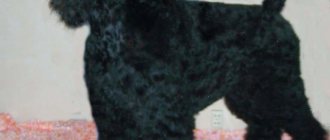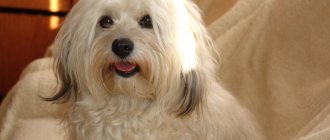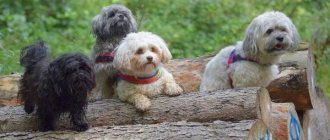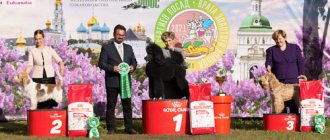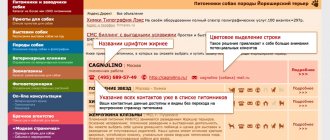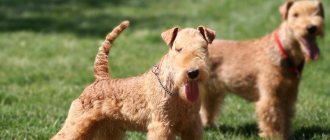Elmirada dog kennel. Papillon and Phalene, Russian Tsvetnaya lapdog
Take the Attention Test! Find 10 differences! (click right here!)
Find the answer Are you bothered by some problem or question? Enter “Breed” or “Name of the problem” into the form, press Enter and you will find out everything about the issue that interests you.
https://dog-care.ru/porody/pitomniki/sobak-russkaya-tsvetnaya-bolonka-v-moskve.html
| Description: | Kennel of small breed dogs: Papillons (butterfly dog) and Russian colored lapdogs |
| Contacts: |
Dog shows and other events - photo and video reports
62 photos + 10 videos Championship of Armenia and Germany at the international exhibition “Planet of Dogs” (CACIB, Fluffy Easter in Skonto) 04/16/2017, Riga
177 photos + 8 videos ZooEXPO 2016. International dog show “Baltic Winner 2016”, LKF/FCI CACIB 12/13.11.2016, Riga
126 photos + 8 videos Specialized exhibition of greyhounds 04/30/2016, Riga
Before adopting a dog from the kennel
Any pet with character and emotions. Call a friend who already has an animal if you have not interacted with animals. Relatives may have a negative attitude towards the decision to adopt a dog - convince them and get their consent. Walk the dog yourself, or arrange with relatives. Remember, the dog is usually walked 3 times a day. If you have children, they should be able to get along with animals. Teach them not to hurt your pet. The child should not touch the pet when she is eating or sleeping. You cannot scare or shout at the animal.
Victoria's Secret
Unique babies with rare colors can be purchased from the owners of the famous Moscow nursery Victoria's Secrets. The nursery is located and officially registered in the city of Voskresensk, Moscow region. It is not difficult to find a puppy here that is at least two months old. Dogs raised by employees of the establishment must undergo certification.
Each animal is equipped with its own brand and puppy card of the Russian Federation of Cynologists. Young pets have a veterinary passport. Vaccinations for dogs are given in accordance with the age calendar, which will guarantee safety when purchasing a pet. Breeders teach their pets to use a litter tray and eat dog food on their own.
If you choose a baby from the specified owner, the puppy will be reserved personally and will not be put up for sale. By purchasing a dog from Victoria's Secret, you can receive advice on the care and maintenance of the baby and the necessary information support from lap-dog breeders.
The first thing to do
Plan when you will take your dog for vaccinations. Bring toys for him to play with. Prepare a place and train your pet to this place. Necessary things:
- Dry food,
- clothes,
- Shampoo,
- Oral hygiene product,
- Brush (comb),
- Claw clipper.
If you want to add your organization, fill out the form below: Indicate the name of the nursery, its description and provide contact information. We will be glad to add you to our directory.
Discussing:
10/25/2018. Articles about the Italian Cane Corso breed Training and sports with Cane Corso Dushka01.10.2021. Russian Toy puppies for sale (smooth-haired)10/18/2018. Caring for a dog A collar with a fastex clasp is the most convenient accessory for dogs02/21/2021. Humor about dogs and other animals Humor about animals 10/19/2017. Caring for a dog Baby named Predator - small dogs12/02/2020. American Staffordshire Terrier Kennel “AMULET DIAMOND”, STAFFORD, Novouralsk, Russia 09/24/2017. Caring for a dog Recommendations for returning animals from the dacha 12/27/2019. What, where, when... 01/25-26/2020 2xFCI-CACIB Memory of Olga Nizova & Cup of 09/22/2017. Feeding dogs Top 5 misconceptions about feeding dogs12/13/2019. Personal photo albums Miniature Schnauzers and Spitz from MinskPuppies for sale
There are puppies
10/03/2022 East European Shepherd puppy for sale, 4 months old. Girl.
Parents: Veo Guardian Legion × Centauri.
RKF documents.
The baby is fully vaccinated and has started a course of educational training. Delivery to another city is possible at the buyer's expense.
call Maria Ilyinichna
Breed description, standards, appearance
The Russian Tsvetnaya is a tiny, curly-haired dog with friendly, expressive dark eyes. According to the international classification, the breed belongs to group 9 “Companions and indoor dogs”.
Russian Tsvetnaya Bolonka: size and constitution
The Russian Tsvetnaya lapdog is a miniature breed with poorly expressed sexual dimorphism. The desired height of the dog is 26 cm at the withers and weighs 3-4 kg.
Although the Russian Tsvetnaya lapdog has not received official recognition from the FCI, it has its own standard, the new edition of which was approved by the decision of the Presidium of SOKO RKF. According to him, a typical dog of a given breed should meet the following description:
- The head is small, proportional, slightly convex in the skull with rounded cheekbones, a poorly developed occipital protuberance, moderately pronounced eyebrows and a short, clear stop. The muzzle is short, dry, slightly tapering towards the tip of the nose. The lobe is black or matches the base color. The jaws are wide with a full set of strong, white teeth, covered by tight, dry lips. Scissor bite, straight bite or overshot bite.
- The ears are triangular in shape and of medium length. Set high and hanging on cartilage. Slightly rounded at the tips and covered with long decorative hair.
- The eyes are medium-sized, straight-set, round with thin, dry, close-fitting eyelids and a soft, friendly gaze. The iris is dark. Russian colored lapdogs with a brown nose are allowed to have light eyes.
- The body is moderately wide, slightly stretched with a pronounced scruff, a strong, straight, long back, a short, slightly convex loin and a rounded, slightly sloping croup. The chest is oval, deep. The abdomen is moderately tucked.
- The limbs are straight, parallel, set wide apart with small, rounded paws, arched toes and strong claws. Movements are free and easy. The characteristic gait is a fast trot.
- The tail is of medium length, set high, completely covered with thick, long hair. Lies on the back or thrown on the back in the shape of a ring.
Serious shortcomings that affect the expert assessment of the Russian colored lapdog include:
- erect or semi-erect ears;
- excessively bulging eyes;
- short and/or crooked forearms;
- creases on the tail;
- snack with waste;
- lack of more than one incisor.
The defects that, if detected, will disqualify a Russian colored lap dog, include:
- obvious signs of dwarfism;
- height more than 28 cm at the withers;
- blue or multi-colored eyes;
- bobtail;
- cryptorchidism (in males);
- undershot, misaligned jaw, visible fangs or incisors.
Russian colored lapdog: color and coat type
The Russian colored lapdog has a thick, long coat with moderately developed or absent undercoat. The dog's hair is styled in waves or large curls. Direct cover is considered a serious fault.
On a note. The coat of the Russian Colored Lapdog cannot be trimmed or sheared. An exception is made only for paws, which are carefully trimmed along the contour.
According to the standard, the Russian colored lapdog can be painted in any color except white, marbled, brindle and spotted. Inconspicuous white markings are acceptable on the dog's fingertips, chest, throat and chin.
Care and maintenance
The Russian colored lapdog is not demanding of space and feels comfortable in a city apartment. A small, clean dog does not cause much trouble and easily gets used to relieving itself in a litter tray.
Of course, this frees the owners from regular hygienic walks, but it obliges them to monitor the cleanliness of the pet’s toilet. An intelligent and fastidious Russian colored lapdog will never go into a dirty litter tray with wet, unpleasant-smelling litter.
Hygiene procedures
The Russian colored lapdog has dense, curly hair that does not require complex grooming. To maintain a neat appearance, the dog is combed 2-3 times a week with a bone or plastic comb with sparse teeth and, as necessary, undergoes a hygienic haircut, shortening the hair between the toes and under the tail.
Long hair growing on the animal's head can be collected with an elastic band so that it does not fall in the eyes.
The thick coat of the Russian colored lapdog has a self-cleaning function and does not require frequent washing. In order not to spoil the structure of the dog's coat, it is washed only in case of severe contamination. For bath procedures, gentle veterinary shampoos are used, and for rinsing, conditioners or nettle decoction are used.
On a note. According to the standard, the Russian colored lap dog should not have partings in its coat. Therefore, after bathing, it is not advisable to dry the dog’s wet coat with a hairdryer while simultaneously using a comb.
The slightly convex eyes of the Russian colored lapdog are covered with thick long hair and have deep skin folds running at the inner corner. To remove dirt and stains accumulated there, they are subjected to regular maintenance. The hair around the eyes is thoroughly combed, the dirt is thoroughly cleaned with a toothbrush with powdered boric acid, and the pellets that appear are combed out.
The ears of the Russian colored lapdog are wiped weekly with cotton swabs soaked in hydrogen peroxide or chlorhexidine, and, if necessary, freed from excess hair growing in the ear canal. They are carefully plucked out with tweezers so that they do not cause itching and do not impede air circulation.
The claws of the Russian colored lapdog rarely wear down naturally. So that they do not interfere with the dog’s movement, they are regularly cut with special clippers, trying not to touch the blood vessels.
Russian Tsvetnaya lapdog - feeding
The Russian Tsvetnaya lap dog is not demanding when it comes to nutrition and eats small portions. Therefore, it is more convenient to feed her with premium or super-premium industrial dryers, such as Belcando, Brit Care or Carnilove. When purchasing a ready-made diet, it is better to pay attention to imported products intended for ornamental breeds.
If you decide not to break tradition and feed your dog natural products, the basis of its menu should be fresh, lean meat with veins and cartilage. You can also give your Russian lapdog giblets and sea fish fillets. It is recommended to introduce them into your pet’s diet twice a week, replacing meat feeding.
As a supplement, the Russian colored lapdog is allowed to be given:
- eggs;
- cereals;
- sour milk.
In order for the Russian colored lapdog to remain healthy and cheerful longer, fatty meats, legumes, confectionery, sausages, bony river fish and any leftovers from the common table must be completely excluded from its menu.
Important! At the age of 2-4 months, the Russian lapdog begins active growth. During this period, it is recommended to feed the puppy 5 times a day. From 5 months, it is enough for a dog to receive food 3-4 times a day. But at this age she begins to change her teeth and her diet needs to be enriched with kefir, cottage cheese and other sources of calcium.
Walking and exercise
The Russian Tsvetnaya lapdog is a decorative breed that does not require special physical activity. To maintain muscle tone and gain new experiences, it is enough for your dog to be outside twice a day for 20-30 minutes.
Important! To prevent the tiny colored lapdog from being harmed by the teeth of its larger counterparts, during walks it must be protected from communicating with aggressive dogs.
Training and education
In the absence of education, the Russian colored lapdog turns into a spoiled creature that can greatly complicate the life of its owners. Therefore, from the first days the puppy appears in the house, he needs to be shown the boundaries of what is permitted and the rules of behavior explained.
To live comfortably with a dog, it is taught to perform basic commands, including “Place!”, “Ugh!”, “Come to me!”, “Stand!”, “Lie down!” and “Sit!” The best time to raise a Russian colored lapdog is considered to be from 3 to 6 months. At this age, the puppy willingly makes contact and quickly learns new knowledge.
On a note. The Russian colored lapdog perceives punishment as an attempt to suppress the will and, in response to tugging or waving, begins to act mischievously. During the training process, instead of yelling at the dog for incorrect behavior, it is better to switch its attention to another action.
Puberty and mating
The Russian colored lapdog reaches sexual maturity at 6-10 months. But it is recommended to knit it no earlier than 2 years. By this age, the dog will have time to fully develop and be able to bear healthy offspring.
Only purebred Russian colored lapdogs with a balanced psyche, excellent health and pedigree exterior are allowed for mating. Crossing is planned for 10-13 days from the start of estrus and is repeated 1-2 days later. Mating is carried out on the male's territory, after introducing and walking the dogs.
Pregnancy in a Russian colored lapdog lasts about two months and ends with the birth of 3-4 puppies.
Caring for puppies
A professional breeder who values his reputation transfers the Russian Colored puppy to its new owners no earlier than he is 2-3 months old. Although by this time the baby no longer requires round-the-clock care, at first he may whine from longing for his mother and littermates. To help the puppy get comfortable, something with the smell of a “nest” is placed on its bedding, which it is recommended to ask the breeder in advance.
As soon as the baby gets used to the new environment, he will begin to explore new possessions. Therefore, in the house you need to hide wires, household chemicals, medicines and other dangerous objects in advance.
To prevent a Russian colored lapdog puppy from becoming infected with an infectious disease, until he has received all vaccinations and completed quarantine, he is not taken out for walks and is not allowed to have contact with other animals.
Russian colored lapdog: what to feed?
Any inexperienced breeder is interested in the question of how to properly feed a lapdog. It is worth noting that representatives of this breed must adhere to a certain diet. Dogs love to eat too much; if they are not limited in food, they will very quickly gain excess weight. You can choose a balanced food for your lapdog. This option will be more acceptable than eating foods of natural origin.
Before you start feeding your puppy your food, you should spend a little time keeping the dog on the diet that it was accustomed to from the breeder. And then gradually switch the puppy to his food.
To properly organize your dog’s nutrition, you should adhere to the following rules:
- Do not give your dog anything from the table; it should not be taught to beg.
- A lap dog should not be spoiled with sweets, they cause allergies.
- Smoked sausages should not be given.
- Try to feed the animal strictly on time.
- After lunch, the pet must be allowed to rest, and only then can you take it outside.
Character of the lap dog
The Russian colored lapdog quickly and easily wins the attention of all family members. She is incredibly playful, and therefore easily finds a common language with children and all family members. Although the animal is quite modest in size, it is distinguished by its endurance. That’s why your lapdog can accompany you even during long walks.
It is also worth noting that the breed has a special level of intelligence. With the right approach to training and the absence of serious punishment and rudeness, the dog very quickly learns not only standard simple commands, but also whole tricks with which it can delight guests.
The lapdog will be a wonderful friend for both the whole family and single people. The animal very quickly and firmly becomes attached to people. It sincerely loves its owners and looks forward to their arrival.
Cute, affectionate dogs are ideal pets for large families. They are very smart and great with children, but they need constant communication; they do not like to be alone.
History of the breed
There are many dog breeds in the world. Among them there are very ancient ones, which are used to breed new species. And there are also very young breeds that have appeared recently. The Russian colored lapdog, bred only in the middle of the last century, belongs to them.
The first dog appeared in Leningrad. From the first days, the breed won the sympathy and love of people of different age categories. The Russian colored lapdog is considered an ornamental animal and belongs to the group of dwarf dogs.
Animal fur
The dog's undercoat is very dense, and the fur itself is soft with large curls, it can be straight or wavy. According to the Russian standard, the entire hair of an animal must be the same length. White color is not allowed. Spotted coloring is considered a fault. All other colors are perfectly acceptable, but they must be solid. The most common colors are: brown, black, beige, grey, grey-tan, grey.
The lapdog has a strong and straight back, a curled tail, the tip of which should lie on the back or slightly on the side. The main requirement is that the tail be close to the back.
